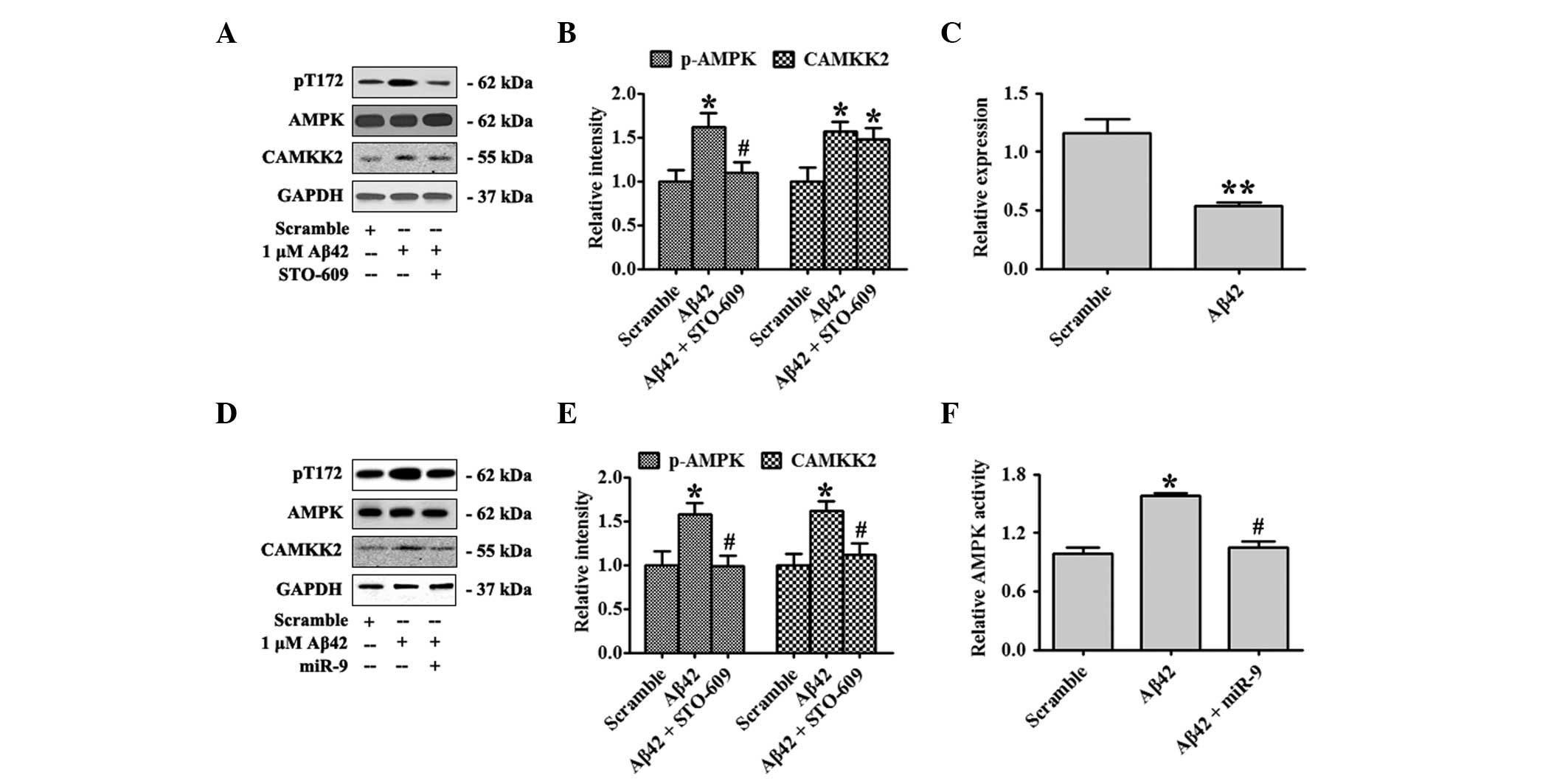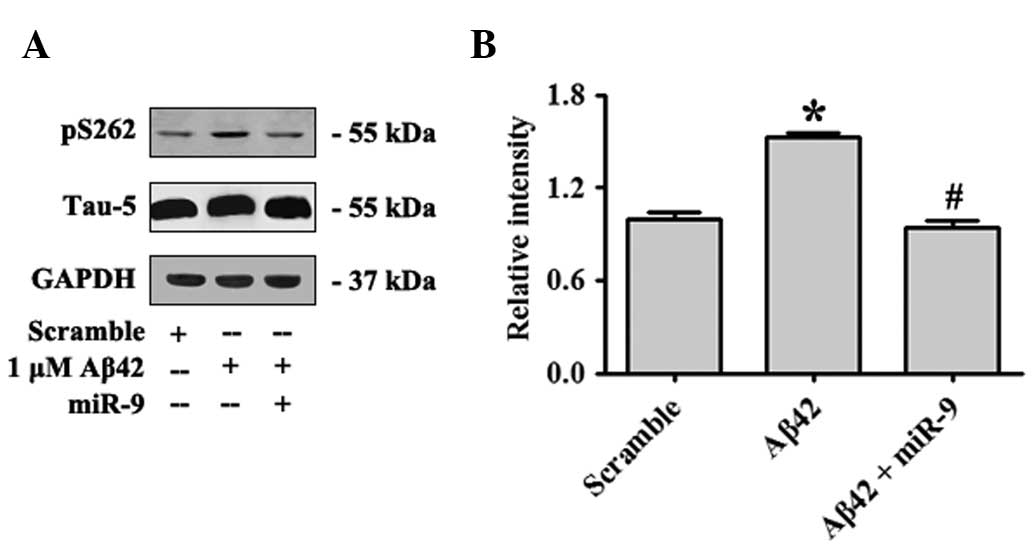|
1
|
Mairet-Coello G, Courchet J, Pieraut S,
Courchet V, Maximov A and Polleux F: The CAMKK2-AMPK kinase pathway
mediates the synaptotoxic effects of Aβ oligomers through tau
phosphorylation. Neuron. 78:94–108. 2013.PubMed/NCBI
|
|
2
|
Wang JZ and Liu F: Microtubule-associated
protein tau in development, degeneration and protection of neurons.
Prog Neurobiol. 85:148–175. 2008. View Article : Google Scholar : PubMed/NCBI
|
|
3
|
Vanitallie TB: Preclinical sporadic
Alzheimer’s disease: target for personalized diagnosis and
preventive intervention. Metabolism. 62(Suppl 1): S30–S33.
2013.
|
|
4
|
Wang JF, Lu R and Wang YZ: Regulation of β
cleavage of amyloid precursor protein. Neurosci Bull. 26:417–427.
2010.
|
|
5
|
Jin M, Shepardson N, Yang T, Chen G, Walsh
D and Selkoe DJ: Soluble amyloid beta-protein dimers isolated from
Alzheimer cortex directly induce Tau hyperphosphorylation and
neuritic degeneration. Proc Natl Acad Sci USA. 108:5819–5824. 2011.
View Article : Google Scholar : PubMed/NCBI
|
|
6
|
Palop JJ, Chin J, Roberson ED, et al:
Aberrant excitatory neuronal activity and compensatory remodeling
of inhibitory hippocampal circuits in mouse models of Alzheimer’s
disease. Neuron. 55:697–711. 2007.PubMed/NCBI
|
|
7
|
Yuan HX, Xiong Y and Guan KL: Nutrient
sensing, metabolism, and cell growth control. Mol Cell. 49:379–387.
2013. View Article : Google Scholar : PubMed/NCBI
|
|
8
|
Nakano A and Takashima S: LKB1 and
AMP-activated protein kinase: regulators of cell polarity. Genes
Cells. 17:737–747. 2012. View Article : Google Scholar : PubMed/NCBI
|
|
9
|
Salminen A, Kaarniranta K, Haapasalo A,
Soininen H and Hiltunen M: AMP-activated protein kinase: a
potential player in Alzheimer’s disease. J Neurochem. 118:460–474.
2011.
|
|
10
|
Park H, Kam TI, Kim Y, et al:
Neuropathogenic role of adenylate kinase-1 in Aβ-mediated tau
phosphorylation via AMPK and GSK3β. Hum Mol Genet. 21:2725–2737.
2012.PubMed/NCBI
|
|
11
|
Kim J, Park YJ, Jang Y and Kwon YH: AMPK
activation inhibits apoptosis and tau hyperphosphorylation mediated
by palmitate in SH-SY5Y cells. Brain Res. 1418:42–51. 2011.
View Article : Google Scholar : PubMed/NCBI
|
|
12
|
Vingtdeux V, Davies P, Dickson DW and
Marambaud P: AMPK is abnormally activated in tangle- and
pre-tangle-bearing neurons in Alzheimer’s disease and other
tauopathies. Acta Neuropathol. 121:337–349. 2011.PubMed/NCBI
|
|
13
|
Fernandez-Hernando C, Ramírez CM, Goedeke
L and Suárez Y: MicroRNAs in metabolic disease. Arterioscler Thromb
Vasc Biol. 33:178–185. 2013. View Article : Google Scholar : PubMed/NCBI
|
|
14
|
Delay C, Mandemakers W and Hebert SS:
MicroRNAs in Alzheimer’s disease. Neurobiol Dis. 46:285–290.
2012.
|
|
15
|
Hébert SS, Horré K, Nicolaï L, et al: Loss
of microRNA cluster miR-29a/b-1 in sporadic Alzheimer’s disease
correlates with increased BACE1/beta-secretase expression. Proc
Natl Acad Sci USA. 105:6415–6420. 2008.PubMed/NCBI
|
|
16
|
Leucht C, Stigloher C, Wizenmann A, Klafke
R, Folchert A and Bally-Cuif L: MicroRNA-9 directs late organizer
activity of the midbrain-hindbrain boundary. Nat Neurosci.
11:641–648. 2008. View
Article : Google Scholar : PubMed/NCBI
|
|
17
|
Schonrock N, Humphreys DT, Preiss T and
Götz J: Target gene repression mediated by miRNAs miR-181c and
miR-9 both of which are down-regulated by amyloid-β. J Mol
Neurosci. 46:324–335. 2012.PubMed/NCBI
|
|
18
|
Schonrock N, Ke YD, Humphreys D, et al:
Neuronal microRNA deregulation in response to Alzheimer’s disease
amyloid-beta. PLoS One. 5:e110702010.PubMed/NCBI
|
|
19
|
Zhu LQ, Zheng HY, Peng CX, et al: Protein
phosphatase 2A facilitates axonogenesis by dephosphorylating CRMP2.
J Neurosci. 30:3839–3848. 2010. View Article : Google Scholar : PubMed/NCBI
|
|
20
|
Rencurel F, Foretz M, Kaufmann MR, et al:
Stimulation of AMP-activated protein kinase is essential for the
induction of drug metabolizing enzymes by phenobarbital in human
and mouse liver. Mol Pharmacol. 70:1925–1934. 2006. View Article : Google Scholar : PubMed/NCBI
|
|
21
|
Handoko M, Grant M, Kuskowski M, et al:
Correlation of specific amyloid-β oligomers with tau in
cerebrospinal fluid from cognitively normal older adults. JAMA
Neurol. 5:594–599. 2013.
|
|
22
|
Gao L, Tian S, Gao H and Xu Y: Hypoxia
increases Aβ-induced tau phosphorylation by calpain and promotes
behavioral consequences in AD transgenic mice. J Mol Neurosci.
51:128–147. 2013.
|
|
23
|
Seward ME, Swanson E, Norambuena A, et al:
Amyloid-β signals through tau to drive ectopic neuronal cell cycle
re-entry in Alzheimer’s disease. J Cell Sci. 126:1278–1286.
2013.
|
|
24
|
Thornton C, Bright NJ, Sastre M, Muckett
PJ and Carling D: AMP-activated protein kinase (AMPK) is a tau
kinase, activated in response to amyloid β-peptide exposure.
Biochem J. 434:503–512. 2011.
|
|
25
|
Yoshida H and Goedert M: Phosphorylation
of microtubule-associated protein tau by AMPK-related kinases. J
Neurochem. 120:165–176. 2012. View Article : Google Scholar : PubMed/NCBI
|
|
26
|
Moolman DL, Vitolo OV, Vonsattel JP and
Shelanski ML: Dendrite and dendritic spine alterations in Alzheimer
models. J Neurocytol. 33:377–387. 2004. View Article : Google Scholar : PubMed/NCBI
|
|
27
|
Manczak M and Reddy PH: Abnormal
interaction of oligomeric amyloid-β with phosphorylated tau:
implications to synaptic dysfunction and neuronal damage. J
Alzheimers Dis. 36:285–295. 2013.
|
|
28
|
Viollet B, Lantier L, Devin-Leclerc J, et
al: Targeting the AMPK pathway for the treatment of Type 2
diabetes. Front Biosci (Landmark Ed). 14:3380–3400. 2009.
View Article : Google Scholar : PubMed/NCBI
|
|
29
|
Cai Z, Yan LJ, Li K, Quazi SH and Zhao B:
Roles of AMP-activated protein kinase in Alzheimer’s disease.
Neuromolecular Med. 14:1–14. 2012.
|
|
30
|
Lu J, Wu DM, Zheng YL, et al: Quercetin
activates AMP-activated protein kinase by reducing PP2C expression
protecting old mouse brain against high cholesterol-induced
neurotoxicity. J Pathol. 222:199–212. 2010. View Article : Google Scholar : PubMed/NCBI
|
|
31
|
Lukiw WJ: Micro-RNA speciation in fetal,
adult and Alzheimer’s disease hippocampus. Neuroreport. 18:297–300.
2007.PubMed/NCBI
|
|
32
|
Ai J, Sun LH, Che H, et al: MicroRNA-195
protects against dementia induced by chronic brain hypoperfusion
via its anti-amyloidogenic effect in rats. J Neurosci.
33:3989–4001. 2013. View Article : Google Scholar : PubMed/NCBI
|
|
33
|
Boissonneault V, Plante I, Rivest S and
Provost P: MicroRNA-298 and microRNA-328 regulate expression of
mouse beta-amyloid precursor protein-converting enzyme 1. J Biol
Chem. 284:1971–1981. 2009. View Article : Google Scholar : PubMed/NCBI
|
|
34
|
Liu W, Liu C, Zhu J, et al: MicroRNA-16
targets amyloid precursor protein to potentially modulate
Alzheimer’s-associated pathogenesis in SAMP8 mice. Neurobiol Aging.
33:522–534. 2012.PubMed/NCBI
|
|
35
|
Hébert SS, Horré K, Nicolaï L, et al:
MicroRNA regulation of Alzheimer’s Amyloid precursor protein
expression. Neurobiol Dis. 33:422–428. 2009.
|
|
36
|
Cogswell JP, Ward J, Taylor IA, et al:
Identification of miRNA changes in Alzheimer’s disease brain and
CSF yields putative biomarkers and insights into disease pathways.
J Alzheimers Dis. 14:27–41. 2008.
|
|
37
|
Tan SL, Ohtsuka T, González A and Kageyama
R: MicroRNA9 regulates neural stem cell differentiation by
controlling Hes1 expression dynamics in the developing brain. Genes
Cells. 17:952–961. 2012. View Article : Google Scholar : PubMed/NCBI
|













